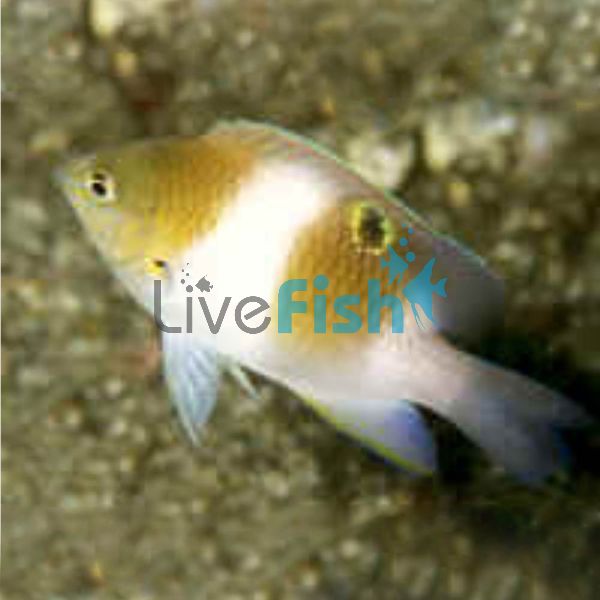Honey Head Damselfish - Medium
Honey Head Damselfish are an attractive fish that can brighten your tank and offer fascinating movement. They can be terrific friends for you and your other fish for many years if given the appropriate care.
The Honey Head Damselfish is honey brown with a white breast devoid of dark blotches. It also has a broad pale bar running down the middle of the body, and blue lines on the top of the head.
As juvenille fish they have a white body, two broad honey brown bars. One of these through the eyes, the other in the middle. They also have a sizable dorsal fin spot with a gold border.
Damselfish are members of the Pomacentridae family. They are related to clownfish and are plankton-feeding species that live on coral reefs in the wild. Even though certain members of this family are known as Chromis, they are still referred to as "Damselfish."
The Atlantic, Indian, and Pacific Oceans are home to Damselfish. Nearly every species of them dwells along reeds, and some even live inside sea anemone tentacles.
Tank Recommendations for Honey Head Damselfish
You should provide them with plenty of live rock. This is porous limestone that has spent some time on the ocean floor and has accumulated life. Life like beneficial bacteria, algae, copepods, amphipods, coral, and sea stars, which should be in any marine tank. Live rock should be the first addition to a new marine tank as it will help to establish the nitrogen cycle, which will help to reduce nitrates in the water. This biological filtering mechanism is crucial to a healthy tank.
The majority of damselfish are robust, healthy fish. It used to be the usual procedure to introduce them first to a new tank so that the symbiotic microbes with them could establish the nitrogen cycle before the addition of more delicate species. Since live rock can accomplish the same goal, it is no longer advised because it places undue strain on the damselfish.
Despite their hardiness, they are susceptible to parasites including marine ich, marine velvet disease, and uronema disease. Marine ich is also known as white spot disease or crypt. The best way to treat these illnesses is with medicine and frequent water changes.
So that your damselfish may create their own domain, use a large tank that holds at least 100 gallons (378.5 litres).
Suitable Tank Buddies
As long as there is enough room in your tank for all of your fish, Damselfish can get along well with peaceful fish like Gobies, Dartfish, and Fairy Wrasses. Additionally, if you are going to add any more aggressive fish, then first make sure the peaceful fish have established themselves in your tank. If you keep them in a tank with small, aggressive fish, you should keep a close eye on them to make sure they aren't being harassed.
Usually Compatible
These Damselfish will flourish in a tank with a few less aggressive species including Dwarf Angelfish, Anthias, Blennies, Boxfish, Clownfish, Crustaceans, and Dragonettes. Goatfish Hawkfish Hogfish and Parrotfish, Pufferfish all make great tank mates.
Sometime Compatible
They will flourish in the absence of huge fish like large Angelfish or Surgeonfish. Batfish, Butterflyfish, Cardinalfish, Filefish, Rays, Squirrelfish, and Triggerfish should all be monitored. The presence of larger fish would most likely prevent natural shoaling and make it more difficult for the Damselfish to find adequate food.
Rarely Compatible
When selecting tank mates, predatory fish should be avoided because Damselfish can be alluring prey. Damselfish do not affect corals or movable invertebrates. They will, however, make a potential meal for Sharks, Scorpionfish, Groupers, and Eels, and Lionfish if kept in the same tank.
Feeding your Honey Head Damselfish
Since damselfish are omnivores, it is simple to select food that will appeal to them. They will eat pellets, flakes, frozen food, and live food, as well as consume algae from your live rock. They should be given vitamin-enriched brine shrimp, mysis shrimp, or other small-chopped shellfish regularly.
To prevent any air from being trapped in their digestive tracts. You should soak pellets with a little bit of water from your tank before feeding them to your fish. As with any fish that consumes plankton in the wild, providing them with meals three times a day is ideal. Regular feedings will help reduce hostility as they will not feel they need to protect their territory and resources.
| Scientific Name | Dascyllus prosopotaenia |
|---|---|
| Care Level | Easy |
| Common Names | White-breasted Damsel, Masked Demoiselle, Honeypot Damsel, Honeyhead Damselfish, Honey-breasted Damsel |
| Diet | Omnivore |
| Fish Family | Pomacentridae |
| Lifespan (years) | 8 |
| Max. Length (cm) | 16 |
| Min. Tank Volume (l) | 378.5 |
| Origin | Atlantic, Indian, and Pacific Oceans |
| Reef Safe | Yes |
| Sociability | Peaceful |
| Venomous | No |
| Water Conditions | SG 1.020-1.025, (72º-78º F) dKH 8-12, pH 8.1-8.4 |




